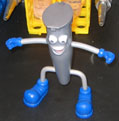
Tite: Next
Author: Michael Crichton, MD
Amazon View
From the guy that brought us Jurassic Park, Sphere (one of my favorite books ever), and Congo (all turned into movies) comes his latest novel, Next. He's also the guy that inspired the show ER. I had forgotten about his medical background and sort of figured since I hadn't heard about him in a while that he was done with. The cover also reminded me about the movie 12 Monkeys and I thought it was going to be about the same thing. But then I go home for winter break and my dad starts talking to me about this book hes reading about gene therapies, cell lines, and transgenic animals. This kind of stuff is right up my alley since its the type of work I do in lab. I figured I had to readthis book since medical science is rarely used for popular fiction.
Overall, I thought the book was pretty good - not great, but good. I think I would have enjoyed it more had I not realized the errors in the science, which is what I'm going to talk about in this blog entry.
NOTE-SPOILER WARNING: If you don't want to know the ending, then don't read the rest...
Problems with the main story line: The primary story involves a cancer patient (Burnett [striking resemblance to the commonly used Burkitt's lymphoma cell line]) who signs up to be a research participant. Crichton glosses over the exact methodology the PI used, but in the end, the PI generates a cell line from Mr. Burnett that produces abundant qualities of a anti-cancer cytokine (molecule). Without telling the patient, the PI sells the cell line to a biotech company and doesn't compensate Mr. Burnett. In retaliation, Burnett plots to contaminate the biotech's stocks of the cell line. When he does this, the biotech hires a bounty hunter (after filing a law suit) to get the cells back. Here's where Crighton starts going wrong in his science. Since Burnett disappears, the bounty hunter goes after Burnett's daughter and her son because they are "genetically identical to their father." Now, you don't need to be a geneticists to know what is wrong with this statement. The daughter is obviously a cross between her father AND her mother, so she would not be genetically identical and thus nullify the claims in the lawsuit. There's only a 50% chance that she happened to inherit her father's genes that possessed the ability to produce cytokine producing cells. Moreover, neither the daughter nor the grandson had cancer and therefore, their bodies would not have been "challenged" in the same way as Mr. Burnett. Their cells would likely not produce much cytokine (if producing alot of cytokines was normal in their bodies due to their genetic make-up, Mr. Burnett likely wouldn't have developed cancer at all, therefore, cytokine production is a response to cancer). Finally, there is a technical problem with just taking biopies from people. Cell lines are incredibly difficult to generate and since their cells were normal, it would have been even more unlikely for them to generate a successful clone. If they did transform the cells (some kind of immortalization procedure), then the law suit would be null because the genetics had been changed. So, in all, Crighton missed many points that he should have known from his research in genetics.
What I liked alot were the issues raised by advances in genetic technologies. I think that these issues are what make the book worth reading. Even though I work with genetics daily, many of these concerns were things I hadn't even thought about nor are they discussed in our pursuit of advancing knowledge. I will write some seperate posts about the problems we face in the future of genetics.


No comments:
Post a Comment